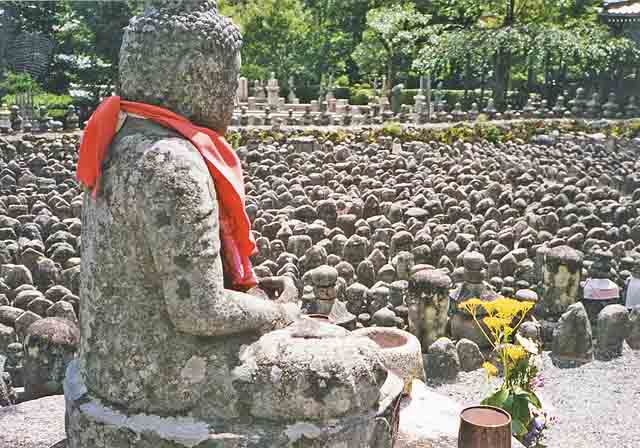Adashino Nembutsu-ji on:
[Wikipedia]
[Google]
[Amazon]


 is a
is a
Pictures and discussion in EnglishPictures in German and English
Buddhist temples in Kyoto {{Japan-religious-struct-stub


 is a
is a Buddhist
Buddhism ( , ), also known as Buddha Dharma and Dharmavinaya (), is an Indian religion or philosophical tradition based on teachings attributed to the Buddha. It originated in northern India as a -movement in the 5th century BCE, and ...
temple
A temple (from the Latin ) is a building reserved for spiritual rituals and activities such as prayer and sacrifice. Religions which erect temples include Christianity (whose temples are typically called churches), Hinduism (whose temples ...
in Ukyo-ku, Kyoto
Kyoto (; Japanese language, Japanese: , ''Kyōto'' ), officially , is the capital city of Kyoto Prefecture in Japan. Located in the Kansai region on the island of Honshu, Kyoto forms a part of the Keihanshin, Keihanshin metropolitan area along wi ...
, Japan. In 811 Kūkai
Kūkai (; 27 July 774 – 22 April 835Kūkai was born in 774, the 5th year of the Hōki era; his exact date of birth was designated as the fifteenth day of the sixth month of the Japanese lunar calendar, some 400 years later, by the Shingon se ...
is said to have founded a temple, then Honen altered it to the present Nenbutsuji. Situated high on a hill overlooking the city from the northwest, it sits in an area where since the Heian period
The is the last division of classical Japanese history, running from 794 to 1185. It followed the Nara period, beginning when the 50th emperor, Emperor Kanmu, moved the capital of Japan to Heian-kyō (modern Kyoto). means "peace" in Japanese ...
people abandoned the bodies of the dead, exposing them to the wind and rain. Now, some eight thousand Buddhist statuettes, which had been scattered around Adashino then collected about 1903, memorialize the soul
In many religious and philosophical traditions, there is a belief that a soul is "the immaterial aspect or essence of a human being".
Etymology
The Modern English noun '' soul'' is derived from Old English ''sāwol, sāwel''. The earliest atte ...
s of the dead. During its well-known 'sento kuyo' ceremony dedicated to the spirits of the dead on the evenings of 23 and 24 August, about ten thousand stone statues are lit up with candles.
In its name, ''Adashino'' is a place name; ''Nenbutsu
Nianfo (, Japanese: , , vi, niệm Phật) is a term commonly seen in Pure Land Buddhism. In the context of Pure Land practice, it generally refers to the repetition of the name of Amitābha. It is a translation of Sanskrit '' '' (or, "recoll ...
'' refers to a mantra (recitation of a buddha's name).
Access
*17, Adashino-chō, Saga-Toriimoto, Ukyō-ku, Kyoto *Kyoto Bus
Kyoto (; Japanese: , ''Kyōto'' ), officially , is the capital city of Kyoto Prefecture in Japan. Located in the Kansai region on the island of Honshu, Kyoto forms a part of the Keihanshin metropolitan area along with Osaka and Kobe. , the cit ...
(not Kyoto City
Bus) Toriimoto Stop: 5 minutes walk
See also
* For an explanation of terms concerning Japanese Buddhism, Japanese Buddhist art, and Japanese Buddhist temple architecture, see theGlossary of Japanese Buddhism
This is the glossary of Japanese Buddhism, including major terms the casual (or brand-new) reader might find useful in understanding articles on the subject. Words followed by an asterisk (*) are illustrated by an image in one of the photo galle ...
.
External links
Pictures and discussion in English
Buddhist temples in Kyoto {{Japan-religious-struct-stub